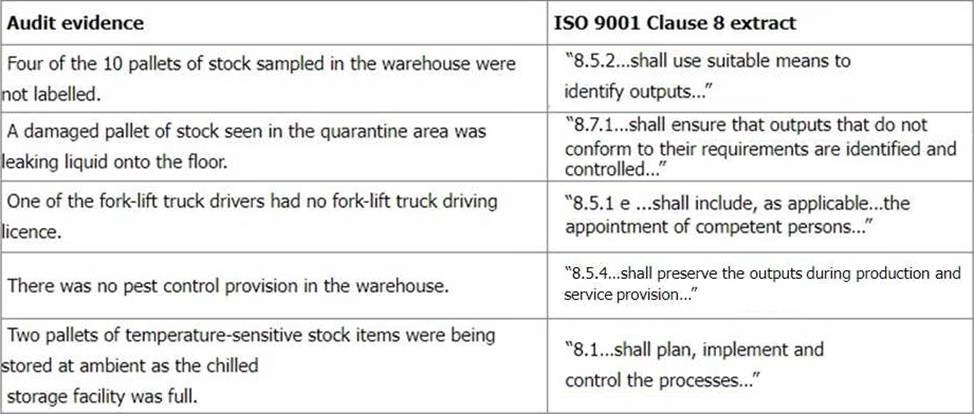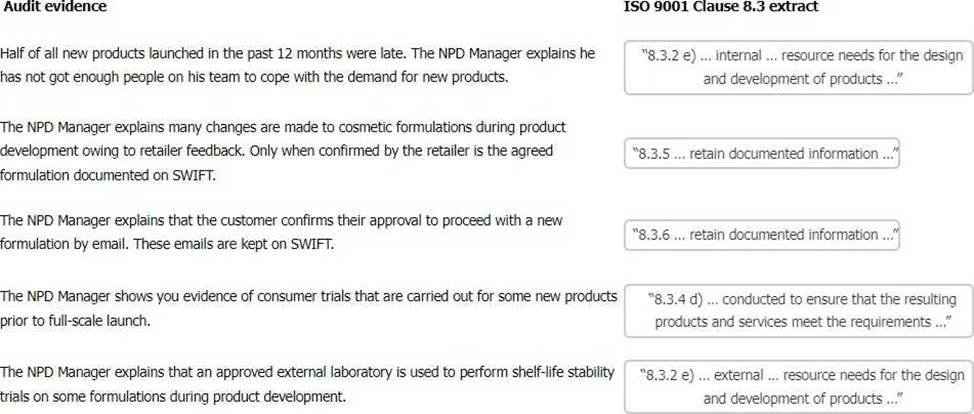PECB ISO-9001 Lead Auditor QMS ISO 9001:2015 Lead Auditor Online Training
PECB ISO-9001 Lead Auditor Online Training
The questions for ISO-9001 Lead Auditor were last updated at Feb 21,2025.
- Exam Code: ISO-9001 Lead Auditor
- Exam Name: QMS ISO 9001:2015 Lead Auditor
- Certification Provider: PECB
- Latest update: Feb 21,2025
You are conducting a third-party audit to ISO 9001 and the next item on your audit plan is ‘internal auditing’.
When reviewing a sample of audit records up to 5 years previously, you find that many contain non-conformance reports and no actions have been taken. You interview the Quality Manager.
You: "I have noted that many of the older files contain non-conformances that have not had any corrective action taken."
Quality Manager: "Because the business is always changing, the departmental managers tell me that the non-conformances are no longer applicable. I made a decision that any non-conformance over 3 years old is automatically closed"
You: "Do you obtain any confirmation beforehand from the appropriate departments that the non-conformances are no longer applicable."
Quality Manager: " No, because they are so old I consider that they are no longer appropriate. Please remember that we take a risk-based approach which means we audit where and when it is considered important to do so.
Select one course of action you would now take from the options.
- A . Interview Top management to determine whether they were aware of and agreed the actions of the Quality Manager
- B . Review all non-conformances reports related to clause 9.2 of ISO 9001
- C . Interview relevant Departmental managers to assess whether the older non-conformances are still valid.
- D . Raise a non-conformance report against clause 9.2.2.e of ISO 9001
During a third-party audit of a pharmaceutical organisation (CD9000) site of seven COVID-19 testing laboratories in various terminals at a major international airport, you interview the CD 9000’s General Manager (GM), who was accompanied by Jack, the legal compliance expert. Jack is acting as the guide in the absence of the Technical Manager due to him contracting COVID-19.
You: "What external and internal issues have been identified that could affect CD9000 and its quality management system?"
GM: "Jack guided us on this. We identified issues like probable competition of another laboratory organisation in the airport, legal requirements on COVID-19 continuously changing, the shortage of competent laboratory analysists, the epidemic declining soon,
shortage of chemicals for the analysis. It was quite a good experience."
You: "Did you document these issues?"
GM: "No. Jack said that ISO 9001 does not require us to document these issues."
You: "How did you determine the risks associated with the issues and did you plan actions to address them?"
GM: "I am not sure. The Technical Manager is responsible for this process. Jack may be able to answer this question in his absence."
Select two options for how you would respond to the General Manager’s suggestion:
- A . I would not accept the legal compliance expert answering the question.
- B . I would ask to audit the Technical Manager by phone.
- C . I would delay the audit until the return of the technical manager
- D . I would look for evidence that the actions resulting from the risk assessment had been taken.
- E . I would ask for a different guide instead of the legal compliance expert.
- F . I would ask the consultant to leave the meeting since he is not an employee of the organisation.
During a second-party audit, the auditor examines the records that are available for the external provider, ABC Forgings, to whom manufacturing has recently been outsourced.
There are standard external provider checklists for three competitors for the contract and there are inspection records from the trial manufacturing batches produced by ABC Forgings. There is no documented evidence of the criteria used to confirm the appointment of ABC Forgings, and no contract or terms and conditions. Ongoing monitoring indicates that external provider performance is satisfactory, but no documented information has been retained.
Select two options for the evidence which demonstrates a nonconformity with clause 8.4 of ISO 9001.
- A . There was no documentation which provided evidence of any monitoring of the external provider.
- B . The auditee required the outsourced products on an urgent basis before the completion of the paperwork.
- C . The auditee did not retain documentation on the selection and evaluation of the external provider.
- D . The external provider asked for the contract details to be verbal only.
- E . There were no receipt inspection records of the incoming materials.
- F . The auditee trusted the external provider because of a long-standing relationship with them.
XYZ Corporation is an organisation that employs 100 people. As the audit team leader, you conduct a certification audit at Stage 1. When reviewing the quality management system (QMS), you find that the objectives have been defined by an external consultant using those of a competitor, but nothing is documented. The Quality Manager complains that this has created a lot of resistance to the QMS, and the Chief Executive is asking questions about how much it will cost.
Which two options describe the circumstances in which you could raise a nonconformity against clause 6.2 of ISO 9001?
- A . The consultant has not interpreted ISO 9001 correctly.
- B . Quality objectives were not established in alignment with the organisation’s quality policy.
- C . Quality objectives are not maintained as documented information.
- D . Establishing quality objectives did not include top management.
- E . The organisation cannot afford to undertake quality objectives all at once.
- F . Quality objectives are not being implemented by the organisations’ personnel.
Noitol is an organisation specialising in the design and production of e-learning training materials for the insurance market. During an ISO 9001 audit of the development department, the auditor asks the Head of Development about the process used for validation of the final course design. She states that they usually ask customers to validate the product with volunteers. She says that the feedback received often leads to key improvements.
The auditor samples the design records for a recently completed course for the 247 Insurance organisation. Design verification was carried out but there was no validation report. The Head of Development advises that this customer required the product on an urgent basis, so the validation stage was omitted. When asked, the Head estimates that this occurs about 50% of the time. She confirms that they always ask for feedback and often make changes. There is no record of feedback in the design file for the course.
The auditor decides to review the training course design process in more depth.
Select three options that provide a meaningful audit trail for this process.
- A . How are students advised about prior learning requirements?
- B . How is customer feedback integrated into the course?
- C . How is the cost of the course calculated?
- D . What risks and opportunities have been notified to interested parties?
- E . How is design documentation controlled and managed?
- F . How is technical content of courses verified as correct?
- G . How is the tutor trained to deliver the completed course?
- H . What are the qualifications of the administrative staff?
An audit team leader arrives at a printing company to carry out a Stage 2 audit for a certification body. At a meeting with the Quality Manager, she is told that they have won their biggest contract from a computer manufacturer to print and compile computer documentation packages. The Quality Manager wants the ISO 9001 certificate to cover the new contract.
During the audit, a team member found that some print jobs had been rejected by several clients over some months due to spelling errors in the print run. The Print Manager blames the new employees they had to take on because of a big contract.
The auditor finds that the responsibility for checking spelling errors is placed on the printer that sets up the print run.
In line with the policy of the certification body, the audit team raise improvement opportunities in the audit report.
Which three of the following options would represent acceptable opportunities for improvement in the report?
- A . Operational planning activities may benefit from a clearer risk-based approach.
- B . The organisation needs to delay its certification to gain more experience of the QMS.
- C . The responsibility for checking printing needs to be independent of the operators.
- D . A business consultant can be recommended for advice on improving operations.
- E . A plan to determine why the errors occur and to prevent them.
- F . An intensive training plan that involves all production personnel.
- G . The recruitment process to include spelling tests to filter out unsuitable candidates.
- H . More process time needs to be allocated to the new employees.
Takitup is a small fabrication organisation that manufactures steel fencing, stairs and platforms for the construction sector. It has been certified to ISO 9001 for some time and has appointed a new Quality Manager. The audit plan during a surveillance audit covers the organisation’s improvement actions and the auditor asks to see the most recent management review meeting minutes.
The auditor finds that the management review report records that none of the improvement actions set by the previous review has been realised for a second time. A new Quality Manager has been brought in at the middle management level to rectify the situation as the organisation is concerned that it might lose its certification.
Select three options that would provide evidence of conformance with clause 10.3 of ISO 9001.
- A . Outsource more processes to external providers
- B . Removing expensive external providers from the database.
- C . An increase in the number of quality staff.
- D . A quality objective to achieve lower reject rates by quality control.
- E . Considering results from the analysis of the effectiveness of corrective actions to determine improvement opportunities.
- F . The certification body auditor reporting fewer nonconformities.
- G . An enhanced customer satisfaction survey score than in the previous year.
- H . Automate the fabrication process to increase profitability.
You are an auditor from a construction organisation who is conducting a second party audit to ISO 9001 at a steel rolling mill producing structural steelwork. When auditing the rolling process, you find that the operator who is unloading the furnace does not use the adjacent infrared pyrometer to measure the appropriate product temperature in readiness for the next production stage.
You: "How do you tell when the billet is ready for the rolling stage?"
Operator: "I’ve done this job for 20 years. I can tell by the bright red colour."
You: "What happens if the colour is wrong?"
Operator: "The billet goes back into the furnace."
You: "Is the pyrometer ever used?"
Operator: "Only in borderline cases."
You continue to interview the operator and find that around 25% of the billets are sent back to the furnace. This includes 80% of the borderline cases.
Select three options that would provide evidence of conformance with clause 9.1.1 of ISO 9001.
- A . Periodic analysis of the results of temperature checks.
- B . Certification of conformance to national standards from the manufacture of the pyrometer.
- C . An increase in the use of the pyrometer by operators.
- D . Maintenance plan for the furnace.
- E . A procedure that provides instruction in taking billet temperature.
- F . Planning for monitoring and measuring the billet temperature.
- G . A quality objective to achieve lower recycle rates for billets.
- H . Annual review records for furnace operators.
DRAG DROP
You are carrying out an audit at a single-site organisation seeking certification to ISO 9001 for the first time. The organisation offers warehousing and export services to customers. Customers are invoiced for the time stock items are stored in the warehouse. Transport to and from the warehouse is controlled by the organisation and approved subcontract transport services are used. The organization does not have its own transport vehicles. Stock items are not purchased by the organisation.
You have gathered audit evidence as outlined in the table. Match the ISO 9001 Clause 8 extract to the audit evidence.
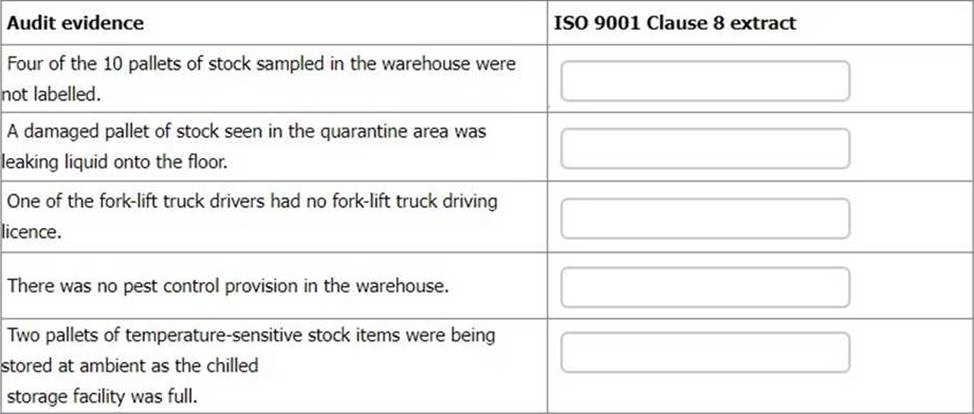
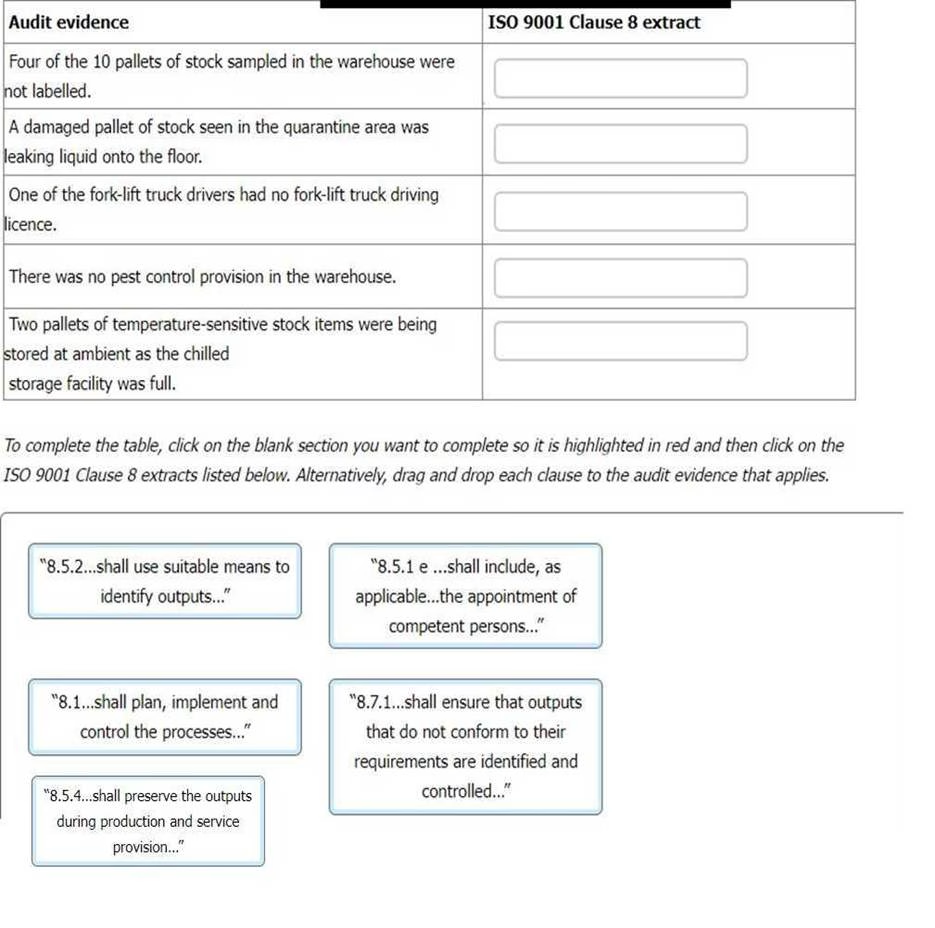
To complete the table, click on the blank section you want to complete so it is highlighted in red and then click on the ISO 9001 Clause 8 extracts listed below. Alternatively, drag and drop each clause to the audit evidence that applies.
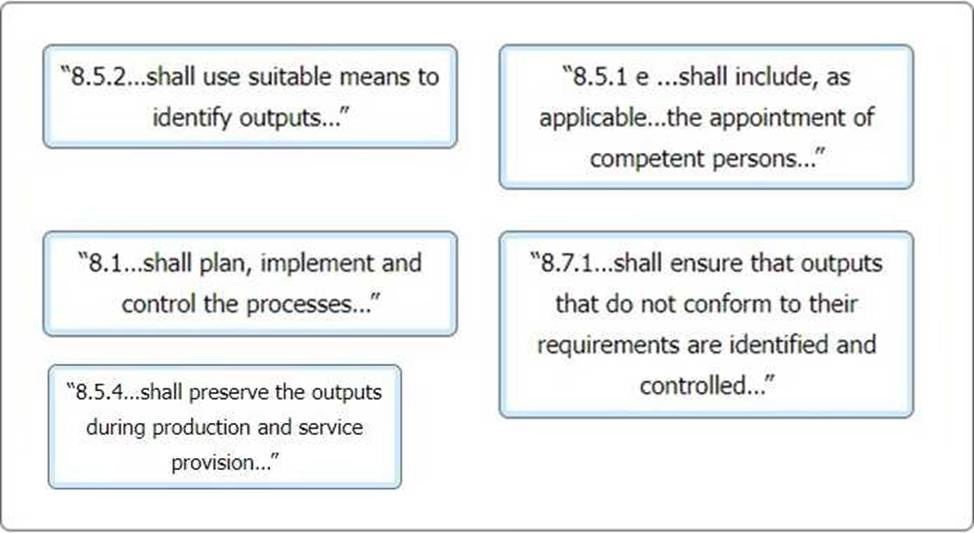
DRAG DROP
You are conducting an audit at a single-site organisation seeking certification to ISO 9001 for the first time. The organisation manufactures cosmetics for major retailers and the name of the retailer supplied appears on the product packaging. Sales turnover has increased significantly over the past five years
You are interviewing the new Product Development Manager. You note that a software application called SWIFT is used to help control the product development process.
You have gathered audit evidence as outlined in the table. Match the ISO 9001 clause 8.3 extracts to the audit evidence.
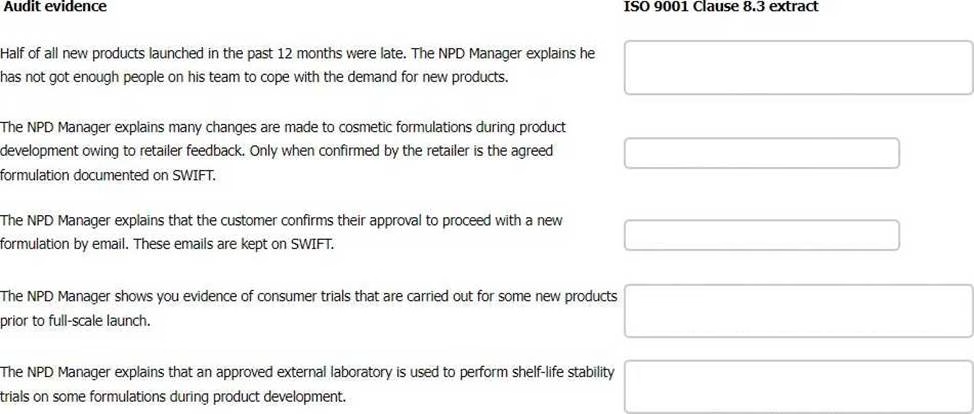
To complete the table click on the blank section you want to complete so it is highlighted in red and then click on the ISO 9001 Clause 8.3 extracts listed below. Alternatively, drag and drop each clause to the audit evidence that applies.

Latest ISO-9001 Lead Auditor Dumps Valid Version with 110 Q&As
Latest And Valid Q&A | Instant Download | Once Fail, Full Refund

